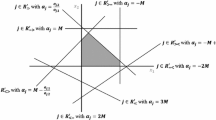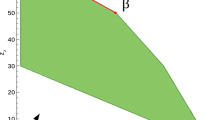Abstract
The purpose of this paper is to discuss the various pivot rules of the simplex method and its variants that have been developed in the last two decades, starting from the appearance of the minimal index rule of Bland. We are mainly concerned with finiteness properties of simplex type pivot rules. Well known classical results concerning the simplex method are not considered in this survey, but the connection between the new pivot methods and the classical ones, if there is any, is discussed.
In this paper we discuss three classes of recently developed pivot rules for linear programming. The first and largest class is the class of essentially combinatorial pivot rules including minimal index type rules and recursive rules. These rules only use labeling and signs of the variables. The second class contains those pivot rules which can actually be considered as variants or generalizations or specializations of Lemke's method, and so they are closely related to parametric programming. The last class has the common feature that the rules all have close connections to certain interior point methods. Finally, we mention some open problems for future research.
Similar content being viewed by others
References
K.M. Anstreicher and T. Terlaky, A monotonic build-up simplex algorithm, Report 91-82. Faculty of Technical Mathematics and Informatics, Delft University of Technology, The Netherlands (1990), to appear in Oper. Res.
I. Adler and N. Megiddo, A simplex algorithm whose average number of steps is bounded between two quadratic functions of the smaller dimension, J. ACM 32(1985)891–895.
D. Avis and V. Chvátal, Notes on Bland's rule, Math. Progr. Study 8(1978)24–34.
D. Avis and K. Fukuda, A pivoting algorithm for convex hulls and vertex enumeration of arrangements and polyhedra, Discr. Comp. Geom. 8(1992)295–313.
R.E. Bixby, Implementing the simplex method: The initial basis, Report TR90-32, Department of Mathematical Sciences, Rice University, TX, USA (1991).
R.E. Bixby, The simplex method: It keeps getting better, Lecture at the14th Int. Symp. on Mathematical Programming, Amsterdam, The Netherlands (1991).
R.E. Bixby, J.W. Gregory, I.J. Lustig, R.E. Marsten and D.F. Shanno, Very large-scale linear programming: A case study in combining interior point and simplex methods, Oper. Res. 40(1992)885–897.
R.G. Bland, New finite pivoting rules for the simplex method, Math. Oper. Res. 2(1977)103–107.
R.G. Bland, A combinatorial abstraction of linear programming. J. Combin. Theory (Ser. B) 23(1977)33–57.
K.H. Borgwardt,The Simplex Method: A Probabilistic Analysis, Algorithms and Combinatorics, Vol. 1 (Springer, 1987).
E.A. Boyd, Resolving degeneracy in combinatorial linear programes: Steepest edge, steepest ascent and closest ascent, Report, Department of Mathematical Sciences, Rice University, TX, USA (1992).
N. Cameron, Stationarity in the simplex method. J. Austral. Math. Soc. 43(1987)137–142.
Y.Y. Chang, Least index resolution of degeneracy in linear complementarity problems, Technical Report 79-14, Department of Operations Research, Stanford University, Stanford, CA, USA (1979).
Y.Y. Chang and R.W. Cottle, Least index resolution of degeneracy in quadratic programming, Math. Progr. 18(1980)127–137.
S.Y. Chang and K.G. Murty, The steepest descent gravitational method for linear programming, Discr. Appl. Math. 25(1989)211–239.
S.S. Chiu and Y. Ye, Simplex method and Karmarkar's algorithm: A unifying structure, Technical Report, Engineering Economic Systems Department, Stanford University, Stanford, CA, USA (1985).
M. Cirina, Remarks on a recent simplex pivoting rule, Math. Oper. Res. 49(1985)187–199.
J. Clausen, A note on Edmonds-Fukuda's pivoting rule for the simplex method, Eur. J. Oper. Res. 29(1987)378–383.
R.W. Cottle, The principal pivoting method revisited, Math. Progr. Ser. B, 48(1990)369–385.
G.B. Dantzig,Linear Programming and Extensions (Princeton University Press, Princeton, NJ, 1963).
H.A. Eiselt and C.-L. Sandblom, External pivoting in the simplex algorithm, Statistica Neerlandica 39(1985)327–341.
J. Folkman and J. Lawrence, Oriented matroids, J. Combin. Theory (Ser. B) 25(1978)199–236.
J.J.H. Forrest and J.A. Tomlin, Implementing the simplex method for the optimization subroutine library, IBM Sys. J. 31(1992)11–25.
K. Fukuda, Oriented matroid programming, Ph.D. Thesis, Waterloo University, Waterloo, Ontario, Canada (1982).
K. Fukuda and T. Matsui, On the finiteness of the criss-cross method, Eur. J. Oper. Res. 52(1991)119–124.
K. Fukuda and M. Namiki, Two extremal behaviors of the criss-cross method for linear complementarity problems, Research Report B-241, Department of Information Sciences, Tokyo Institute of Technology, Tokyo, Japan (1991).
K. Fukuda and T. Terlaky, A general algorithmic framework for quadratic programming and a generalization of Edmonds-Fukuda's rule as a finite version of the Van de Panne-Whinston method, Preprint, Eötvös University, Budapest (1989).
K. Fukuda and T. Terlaky, Linear complementarity and oriented matroids, J. Oper. Res. Soc. Japan 35(1992)45–61.
T. Gal, Degeneracy graphs — Theory and application: A state-of-the-art survey, Report No. 142, Fern Universität Hagen, Germany (1989).
T. Gal and F. Geue, The use of the TNP-rule to solve various degeneracy problems, Report No. 149a, Fern Universität Hagen, Germany (1990).
S. Gass and Th. Saaty, The computational algorithm for the parametric objective function, Naval Res. Log. Quarterly 2(1955)39–45.
F. Geue, Eine neue Pivotauswahlregel und die durch sie induzierten Teilgraphen des positiven Entartungsgraphen, Report No. 141, Fern Universität Hagen, Germany (1989).
P.E. Gill, W. Murray, M.A. Saunders and M.H. Wright, A practical anti-cycling procedure for linearly constrained optimization, Math. Progr. 45(1989)437–474.
D. Goldfarb, Worst case complexity of the shadow vertex simplex algorithm, Report, Department of Industrial Engineering and Operations Research, Columbia University, New York, USA (1983).
D. Goldfarb and J.J.H. Forrest, Steepest edge simplex algorithm for linear programming, Math. Progr. 57(1992)341–374.
M. Haimovitz, The simplex method is very good! — On the expected number of pivot steps and related properties of random linear programs, Report, Columbia University, New York, USA (1983).
P.M.J. Harris, Pivot selection methods for the Devex LP code, Math. Progr. 5(1973)1–28.
B. Hattersly and J. Wilson, A dual approach to primal degeneracy, Math. Progr. 42(1988)135–176.
D. den Hertog, C. Roos and T. Terlaky, The linear complementarity problem, sufficient matrices and the criss-cross method, Lin. Alg. Appl. 187(1993)1–14.
D. den Hertog, C. Roos and T. Terlaky, The inverse barrier method for linear programming, Report No. 91-27, Faculty of Technical Mathematics and Informatics, Delft University of Technology, The Netherlands (1991).
D. Jensen, Coloring and duality: Combinatorial augmentation methods, Ph.D. Thesis, School of OR and IE, Cornell University, Ithaca, NY, USA (1985).
J.E. Kalan, Machine inspired enhancements of the simplex algorithm, Technical Report CS75001-R, Computer Science Department, Virginia Polytechnical University, Blacksburg, VA, USA (1976).
N. Karmarkar, A new polynomial-time algorithm for linear programming, Combinatorica 4(1984)373–395.
L.G. Khachian, Polynomial algorithms in linear programming, Zhurnal Vichislitelnoj Matematiki i Matematischeskoi Fiziki 20(1980)51–68 [in Russian transl: USSR Comp. Math. Math. Phys. 20(1980)53–72.
E. Klafszky and T. Terlaky, Remarks on the feasibility problems of oriented matroids, Ann. Univ. Sci. Budapestiensis de Rolando Eötvös Nominatae, Sectio Computatorica, 7(1987)155–157.
E. Klafszky and T. Terlaky, Variants of the Hungarian method for solving linear programming problems. Math. Oper. und Stat., ser. Optimization 20(1989)79–91.
E. Klafszky and T. Terlaky, Some generalizations of the criss-cross method for quadratic programming. Math. Oper. und Stat., ser. Optimization 24(1992)127–139.
E. Klafszky and T. Terlaky, Some generalizations of the criss-cross method for the linear complementarity problem of oriented matroids, Combinatorica 9(1989)189–198.
E. Klee and G.J. Minty, How good is the simplex algorithm? in:Inequalities — III, ed. O. Shisha (Academic Press, New York, 1972) pp. 159–175.
V. Klee and P. Kleinshcmidt, Thed-step conjecture and its relatives, Math. Oper. Res. 12(1987)718–755.
E. Klotz, Dynamic pricing criteria in linear programming, Technical Report SOL. No. 88-15, Systems Optimization Laboratory, Stanford University, Stanford, CA, USA (1988).
K.O. Kortanek and J. Zhu, New purification algorithms for linear programming, Naval Res. Log. Quarterly 35(1988)571–583.
H.P. Künzi and H. Tzschach, The duoplex-algorithm, Numer. Mathematik 7(1965)222–225.
C.E. Lemke, Bimatrix equilibrium points and mathematical programming, Manag. Sci. 11(1965)681–689.
I. Lustig, The equivalence of Dantzig's self-dual parametric algorithm for linear programs to Lemke's algorithm for linear complementarity problems applied to linear programming, Technical Report SOL 87-4, Department of Operations Research, Stanford University, Stanford, CA, USA (1987).
T.L. Magnanti and J.B. Orlin, Parametric linear programming and anti-cycling pivoting rules, Math. Progr. 41(1988)317–325.
N. Megiddo, On finding primal- and dual-optimal bases, ORSA J. Comp. 3(1991)63–65.
N. Megiddo, Switching from a primal-dual Newton algorithm to a primal-dual (interior) simplex-algorithm, RJ 6327 (61996), IBM Almaden Research Center, San Jose, CA, USA (1988).
K.G. Murty, A note on a Bard type scheme for solving the complementarity problem, Opsearch 11(1974)123–130.
K.G. Murty,Linear and Combinatorial Programming (Krieger, Malabar, USA, 1976).
K.G. Murty, Computational complexity of parametric linear programming, Math. Progr. 19(1980)213–219.
K.G. Murty, The gravitational method of linear programming, Opsearch 23(1986)206–214.
K.G. Murty,Linear Complementarity, Linear and Nonlinear Programming, Sigma Series in Applied Mathematics, Vol. 3 (Heldermann, Berlin, 1988).
K.G. Murty, A new interior variant of the gradient projection method for linear programming, Technical Report No. 85-18, Department of Industrial and Operations Engineering, The University of Michigan, Ann Arbor, MI 48109-2117, USA (1985).
M. Namiki and T. Matsui, Some modifications of the criss-cross method, Research Report, Department of Information Sciences, Tokyo Institute of Technology, Tokyo, Japan (1990).
P.-Q. Pan, Practical finite pivoting rules for the simplex method, OR Spektrum 12(1988)219–225.
K. Paparrizos, Pivoting rules directing the simplex method through all feasible vertices of Klee-Minty examples, Opsearch 26(1989)77–95.
K. Paparrizos, An exterior point simplex algorithm. Lecture at theEURO-TIMS Conf., Belgrade, Jugoslavia (1989).
K. Paparrizos, A simplex algorithm with a new monotonicity property, Working Paper (1991).
K. Paparrizos, An infeasible (exterior point) simplex algorithm for assignment problems, Math. Progr. 51(1991)45–54.
C. Roos, A pivoting rule for the simplex method which is related to Karmarkar's potential function, Manuscript, Faculty of Technical Mathematics and Informatics, Delft University of Technology, The Netherlands (1986).
C. Roos, An exponential example for Terlaky's pivoting rule for the criss-cross simplex method, Math. Progr. 46(1990)78–94.
D.M. Ryan and M.R. Osborne, On the solution of highly degenerate linear programmes, Math. Progr. 41(1988)385–392.
A. Schrijver,Theory of Linear and Integer Programming (J. Wiley, 1987).
A. Sehti and G. Thompson, The pivot-and-probe algorithm for solving a linear problem, Math. Progr. 29(1984)219–233.
R.E. Stone and C.A. Tovey, The simplex and projective scaling algorithms as iteratively reweighted least squares methods, SIAM Rev. 33(1991)220–237.
A. Tamura, private communication (1991).
A. Tamura, H. Takehara, K. Fukuda, S. Fujishige and M. Kojima, A dual interior primal simplex method for linear programming. J. Oper. Res. Soc. Japan 31(1988)413–430.
T. Terlaky, A finite criss-cross method for oriented matroids, J. Combin. Theory (Ser. B) 42(1987)319–327.
T. Terlaky, A convergent criss-cross method, Math. Oper. und Stat., ser. Optimization 16(1985)683–690.
T. Terlaky, A new algorithm for quadratic programming, Eur. J. Oper. Res. 32(1987)294–301.
M.J. Todd, Complementarity in oriented matroids, SIAM J. Alg. Discr. Math. 5(1984)467–485.
M.J. Todd, Linear and quadratic programming in oriented matroids, J. Combin. Theory (Ser. B) 39(1985)105–133.
M.J. Todd, A. Dantzig-Wolfe-like variant of Karmarkar's interior-point linear programming algorithm, Oper. Res. 38(1990)1006–1018.
M.J. Todd, Polynomial expected behavior of a pivoting algorithm for linear complementarity and linear programming problems, Math. Progr. 35(1986)173–192.
A. Tucker, A note on convergence of the Ford-Fulkerson flow algorithm, Math. Oper. Res. 2(1977)143–144.
Zh. Wang, A conformal elimination-free algorithm for oriented matroid programming, Chin. Ann. Math. 8(B1)(1987).
Zh. Wang, A modified version of the Edmonds-Fukuda algorithm for LP problems in the general form, Asia-Pacific J. Oper. Res. (1989).
Zh. Wang, A general deterministic pivot method for oriented matroid programming, Chin. Ann. Math. (1990).
Y. Ye and J.A. Kaliski, Further results on build-up approaches for linear programming, Lecture at theORSA/TIMS Meeting, Anaheim, CA, USA (1991).
N. Zadeh, What is the worst case behavior of the simplex algorithm?, Technical Report No. 27, Department of Operations Research, Stanford University, Stanford, CA, USA (1980).
S. Zhang, On anti-cycling pivoting rules for the simplex method, Oper. Res. Lett. 10(1991)189–192.
G.M. Ziegler, Linear programming in oriented matroids, Technical Report No. 195, Institut für Mathematik, Universität Augsburg, Germany (1990).
S. Zionts, The criss-cross method for solving linear programming problems, Manag. Sci. 15(1969)426–445.
Author information
Authors and Affiliations
Additional information
On leave from the Eötvös University, Budapest, and partially supported by OTKA No. 2115.
Rights and permissions
About this article
Cite this article
Terlaky, T., Zhang, S. Pivot rules for linear programming: A survey on recent theoretical developments. Ann Oper Res 46, 203–233 (1993). https://doi.org/10.1007/BF02096264
Issue Date:
DOI: https://doi.org/10.1007/BF02096264




